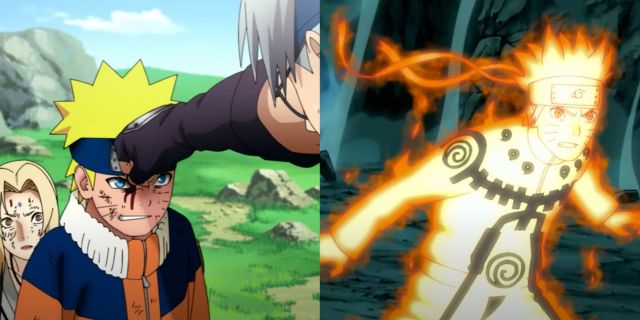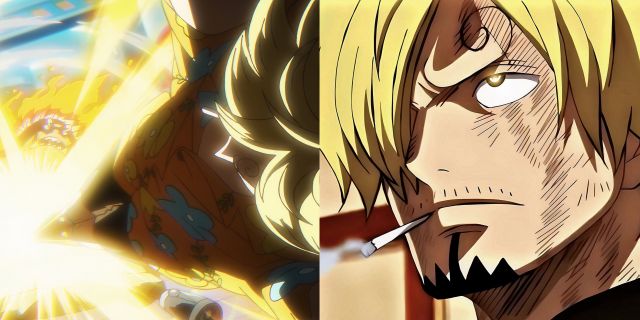Highlights
- Naruto’s journey initially emphasized that anyone can achieve greatness through hard work and perseverance.
- Naruto’s growth was depicted as a result of conquering his innate gifts and burdens, shifting the narrative towards destiny.
- The introduction of prophecies and Naruto’s lineage shifted the story to a “chosen one” narrative, altering the messaging of the series.
Boisterous and ambitious, the version of Naruto Uzumaki first introduced at the start of Part I of Naruto, was someone who believed that anything could be accomplished through sheer grit and hard work. His ideals, and those of the series as a whole, were centered on the notion that one’s origins were not indicative of what they could achieve. As a result, the idea that anyone could reach great heights in the shinobi world simply through sheer perseverance and dedication, even if they did not possess any innate talent, was promoted through Naruto’s own ideology.
However, this sentiment soon gave way to a different narrative, as circumstances changed and Naruto’s own growth was depicted as a consequence of him conquering the gifts and burdens he had been born with. One particularly important moment that triggered the start of this thematic shift, was the debut of Nine Tails Chakra Mode in Part II of Naruto, which signaled the beginning of this process of course correction. In many ways, this moment paved the way for further divergences in the series’ messaging, remolding the narrative as a whole to better fit the direction it veered towards when all of its character arcs approached their conclusions.
A Matter Of Resolve

An orphan who struggled to rise through the Konoha Academy, Naruto Uzumaki was deemed a failure and a troublemaker by most of his peers and mentors, with little talent for any shinobi combat skills. Although he harbored dreams of becoming Hokage, most of his comrades initially believed his statements to be mere daydreams rather than achievable goals. The only thing he really had going for him, were his innately high reserves of chakra, as well as the monstrous power of the Nine-Tails sealed within him.
Due to these two factors, he was able to perform risky techniques such as the Multiple Shadow Clone Technique which could be life-threatening to anyone with limited chakra reserves due to how it divided a user’s chakra among the clones they created. In time, Naruto pushed himself to his limits against opponents who were far more powerful than him, and managed to scrape through by the skin of his teeth through sheer tenacity and the will to continue fighting against impossible odds.
His battle against Neji in the Chunin Exams was a pivotal moment in the development of this character arc, where he beat someone who was regarded as a prodigy of his clan, and showed him how anyone would change their fate. With each confrontation, Naruto acquired new skills, honed his battle intelligence, and grew stronger, proving himself to be a late bloomer rather than someone without any natural aptitude for the life of a shinobi. All of Naruto’s toiling and failures were what made his journey so relatable and inspiring for most viewers, and contributed heavily to the series’ immense popularity as a whole.
One such instance that deserves mention here is his training to learn the Rasengan during the Search for Tsunade Arc of Part I. Series creator Masashi Kishimoto depicted Naruto’s struggle with learning the Fourth Hokage’s technique in painstaking detail. Eventually, there was an immense payoff at the climax of the arc, when he found a solution to master it in the heat of battle against a far more experienced shinobi in Kabuto Yakushi. By the end of Part I, Naruto had proved himself to be a shinobi on par with the geniuses among his peers in the village, including his main rival, Sasuke.
Flipping The Narrative

This idea of forging one’s own destiny by putting in the required work, was something that persisted well into Part II, most notably when Naruto developed Wind Release: Rasenshuriken, and learned senjutsu in Mount Myoboku. In both instances, he had to endure grueling periods of training, where his efforts had limited success, and the path towards his objective was always slow and labored.
It was only through slow, repeated efforts, and a willingness to never give up, that Naruto’s growth curve began to ascend higher and higher, culminating in his defeat of Pain. While it could be said that he had help from the Nine-Tails in this battle, his victory was predominantly a consequence of the skills he had acquired throughout his journey as a shinobi. Quite a lot of this changed with the onset of the Fourth Shinobi World War, where the standard of combatants was far beyond anything seen in the series till that point.
Naturally, this necessitated another power up for Naruto in the form of mastering the Nine-Tails’ chakra, and this time, the path was less slow, grueling, or labored. Moreover, the subsequent boost in strength he attained put him firmly above virtually anyone else on the battlefield, to the point where he was outclassing even the Five Kage. That is not to say that he did not have to struggle to attain this new level of strength, but rather, to illuminate how the power up in question, was a precursor to further augmentations that would slightly diminish the impact of the original message embodied in Naruto’s journey.
From Effort To Preordained Destiny

Even as far back as his training on Mount Myoboku, there was talk of a prophecy about a student of Jiraiya’s who would one day alter the fate of the entire shinobi world. Later on, the introduction of the Tailed Beasts, and Hagoromo Otsutsuki, sowed the seeds for another prophecy, about an individual who would unite all nine forms of living chakra which were created from the Ten-Tails by the Sage of Six Paths. While Naruto’s mastery of the Nine-Tails’ chakra had already been foreshadowed for quite some time, these new pieces of information put an entirely different spin on what it meant.
These details only seemed like minor changes in the grand scheme of things, but they were slowly pushing Naruto’s story away from one of an everyman who grew from effort, towards a more archetypal “chosen one” style of narrative. Additionally, the revelation of his father being the Fourth Hokage, and his mother being the Nine-Tails’ previous jinchuriki served to reinforce this new direction.
Once again, none of this takes away from Naruto’s effort, and the impact is solely limited to the nature of the messaging put forth by the series. This change was firmly set in stone with the introduction of Six Paths Sage Mode and the reveal of Naruto as a reincarnation of Asura Otsutsuki, which altered the ideals of Naruto as a show forever, and cast a shadow on its protagonist’s own struggles in rising from seemingly humble beginnings to become one of the most powerful shinobi in history.
Naruto is available to stream on Crunchyroll.











Leave a Reply